最新人教版新目标七年级英语下册 Unit 10 I’d like some noodles Section B(2)ppt课件
- 格式:ppt
- 大小:1.52 MB
- 文档页数:21
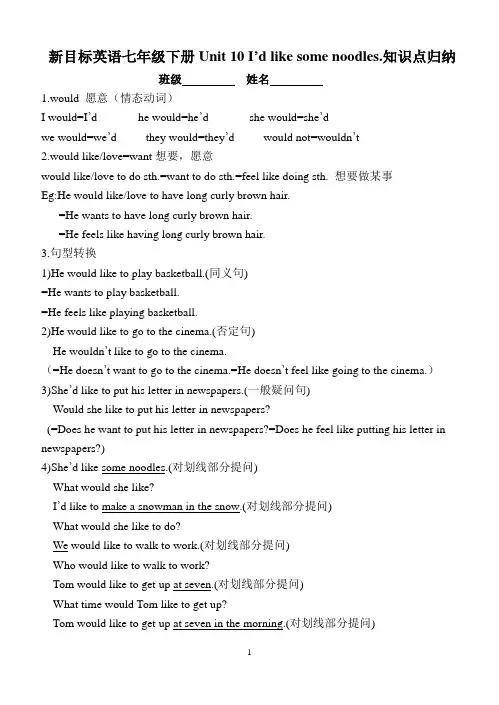
新目标英语七年级下册Unit 10 I’d like some noodles.知识点归纳班级姓名1.would 愿意(情态动词)I would=I’d he would=he’d she would=she’dwe would=we’d they would=they’d would not=wouldn’t2.would like/love=want想要,愿意would like/love to do sth.=want to do sth.=feel like doing sth. 想要做某事Eg:He would like/love to have long curly brown hair.=He wants to have long curly brown hair.=He feels like having long curly brown hair.3.句型转换1)He would like to play basketball.(同义句)=He wants to play basketball.=He feels like playing basketball.2)He would like to go to the cinema.(否定句)He wouldn’t like to go to the cinema.(=He doesn’t want to go to the cinema.=He doesn’t feel like going to the cinema.)3)She’d like to put his letter in newspapers.(一般疑问句)Would she like to put his letter in newspapers?(=Does he want to put his letter in newspapers?=Does he feel like putting his letter in newspapers?)4)She’d like some noodles.(对划线部分提问)What would she like?I’d like to make a snowman in the snow.(对划线部分提问)What would she like to do?We would like to walk to work.(对划线部分提问)Who would like to walk to work?Tom would like to get up at seven.(对划线部分提问)What time would Tom like to get up?Tom would like to get up at seven in the morning.(对划线部分提问)When would Tom like to get up?He’d like to play basketball at school.(对划线部分提问)Where would he like to play basketball?I’d like to see the giraffes. Because they are smart.(对划线部分提问)Why would you like to see the giraffes?I would like to go to school on foot.(对划线部分提问)How would you like to go to school?They’d like two potatoes.(对划线部分提问)How many potatoes would they like?They’d like a little milk.(对划线部分提问)How much milk would they like?I’d like a medium bowl of noodles.(对划线部分提问)What size bowl of noodles would you like?I’d like some beef and tomato noodles. (对划线部分提问)What kind of noodles would you like?5)I’d like some beef and potato noodles.(同义句)=I’d like some noodles with beef and potatoes.How old are you?(同义句)=What’s your age?6)Can you tell me? What does he want?(合并句子)Can you tell me what he wants?4.Would you like some noodles? 你想要一点面条吗?Yes,please. 是的。
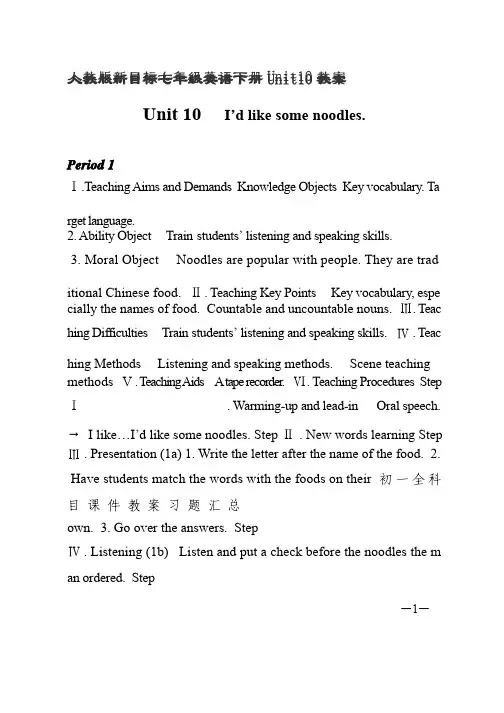
—1—人教版新目标七年级英语下册Unit10教案Unit 10I’d like some noodles.Period 1 Ⅰ.Teaching Aims and Demands Knowledge Objects Key vocabulary. Ta rget language. 2. Ability Object Train 2. Ability Object Train students’students’students’ listening and speaking skills. listening and speaking skills.3. Moral Object Noodles are popular with people. They are trad itional Chinese food. Ⅱ. Teaching Key Points Key vocabulary, espe cially the names of food. Countable and uncountable nouns. Ⅲ. Teac hing Difficulties Train hing Difficulties Train students’students’students’ listening and speaking skills. listening and speaking skills. Ⅳ. Teac hing Methods Listening and speaking methods. Scene teaching methods Ⅴ. T eaching Aids A tape recorder . Ⅵ. Teaching Procedures Step Ⅰ. Warming-up and lead-in Oral speech.→ I like I like…I’…I’…I’d like some noodles. Step d like some noodles. Step Ⅱ. New words learning Step Ⅲ. Presentation (1a) 1. Write the letter after the name of the food. 2. Have students match the words with the foods on their 初一全科目课件教案习题汇总语文数学英语历史地理own. 3. Go over the answers. StepⅣ. Listening (1b) Listen and put a check before the noodles the m an ordered. StepⅤ. Pairwork(1c) Ask students to practice similar conversation s in pairs. Students take turns to be the customer and the noodles ma ker . StepⅥ. Summary and homework Remember the words and practice the target language.Period 2Ⅰ.Teaching Aims and Demands 1. Knowledge Objects Target language Ability Object Train Ability Object Train students’students’students’ listening and speaking skills. Train stude listening and speaking skills. Train stude nts’nts’ communicative competence. Moral Object Noodles are popular communicative competence. Moral Object Noodles are popular with people. They are traditional Chinese food. Ⅱ. Teaching Key Poi nts T h e t a r g e t l a n g u a g e u s e d f o r a s k f o r a n d g i v e p e r s o n a l information. Order food. Ⅲ. Teaching Difficulties Train Train students’students’students’ listening and speaking skills. Train listening and speaking skills. Train listening and speaking skills. Train students’students’students’ commu commu nicative competence. Ⅳ. Teaching Methods Listening and speaking methods. Scene teaching methods Ⅴ. T eaching Aids A tape recorder Ⅵ. Teaching Procedures Step Ⅰ. Warming-up and revision Oral speech and free talk. StepⅡ. Listening (2a 2b) 1. . Listening (2a 2b) 1. YY o u ’r e t o listen and check the names of the foods you hear on the tape. 2. Play the recording twice. Then che ck the answers. 3. P lay th e s ame record ing ag ain. Lis t en carefully and fill in the blanks. StepⅢ. Pairwork (2c,2d) 1. Work with a partner. One is a customer and t he other is a waiter. 2. Invite several pairs of students to act out the ir conversations in front of the class. 3.Have some students role-p lay the conversations in pairs,then explain it to the class. StepⅣ. Grammar Focus G u i d et h e s t u d e n t s t o m a k e s o m e s e n t e n c e s w i t h I ’d , H e ’d and and They’d.They’d.They’d. Step StepⅤ. Conversation practice (3a ,3b) 1. You are to match each question wi th an answer. 2. Get students to do the task in pairs. 3. Put students i nto pairs. One is working in a noodles h o u s e. T h e o t h e r i s t h e c u s t o m e r. G e t t h e p a i r s t o s t a r t t h e activity . Ste pⅥ. Summary and homework 1. S u m m a r yt h e t a r g e t l a n g u a g e w e ’v e l e a r n e d i n t h i s class. 2. Reread the conversa tion in 3a. try to recite it. 3. Write down the conversation in 3c.Period 3Ⅰ. T . Teaching Aims and Demands Knowledge Objects Key vocabulary eaching Aims and Demands Knowledge Objects Key vocabulary . T . Tar ar get language. 2. Ability Object Train get language. 2. Ability Object Train students’students’ listening and speaking skill s. Train s. Train students’students’students’ communicative competence. 3. Moral Object Every communicative competence. 3. Moral Object Every one should choose foods which are good for h is health. Ⅱ. T eachi ng Key Points Learn how to ask for and give personal information an d write down the information. Ⅲ. Teaching Difficulties Learn howto ask for and give personal information and write down the i nformation. Ⅳ. Teaching Methods Practicing methods. Scene teach ing methods Ⅴ. T eaching A ids A tape recorder Ⅵ. Teaching Procedures StepⅠ.Warming-up and lead-in Oral speech. Describe one .Warming-up and lead-in Oral speech. Describe one’’s preferenc es. StepⅡ. New words learning. Porridge onion fish pancake Step Ⅲ. Presentation (1a 1b) 1. Match the words with the pictures. Write the letter of the food on the blank line before its name.2. Circle the things you like in the picture. And make an “×”“×” nex nex t to the things you t to the things you don’t don’t don’t like. Step like. StepⅣ. Listening (1c,1d) 1. Listen carefully and circle in activity 1a th e words that you hear on the tape. 2. Play the same recording again. W Write down the rite down the rite down the customer’s customer’s customer’s address, telephone number and what he or address, telephone number and what he or ders. 3.Check the answers. StepⅤ. Pairwork (2a) 1. Put students into pairs. Ask questions abo ut what they door eat on their birthdays. 2. Invite more advanced students t o demonstrate how to do the activity o demonstrate how to do the activity. Step . StepⅥ.Summary and homework Remember the key words and target la nguage.Period 4Ⅰ. T . Teaching Aims and Demands Knowledge Objects Learn to read and eaching Aims and Demands Knowledge Objects Learn to read and write an ad for House of Dumplings. 2. Ability Object Train student s’s’ reading and writing skills. Train reading and writing skills. Train reading and writing skills. Train students’students’students’ integrating skills. 3. Moral integrating skills. 3. Moral Object Keep healthy. Ⅱ. Teaching Key Points Learn how to order fo od. Learn to write an ad for House of Dumplings. Ⅲ. T . Teaching Diffic eaching Diffic ulties Learn how to order food. Learn to write an ad for House of D umplings. Ⅳ. Teaching Methods reading and writing methods. Practi cing methods Ⅴ. T eaching A ids A tape recorder Ⅵ. Teaching Procedure s Step I. Warming-up and revision Oral speech and dictation. Step II.R eading and answering(2b,2c) Do 2b:Ask students to read the article and complete the c h a r t ,t h e n c h e c k t h e a n s w e r s.E x p l a i n t h e k e y p o i n t s t o the class. D o 2c :H a v e s t u d e n t s r e a d t h e a r t i c l e a g a i n a n d a n s w e r t h e questions,then check the answers. Step III. Reading (3a) Fill in the blank lines, usi ng words from the box. Get students to complete the paragraph on t heir own. Step IV . Writing (3b,3c) 1. W r i t e y o u r o w n a d. P l e a s e u s e t h e a d i n a c t i v i t y 3a a s a model. 2. Us e the sample version in activity 1c to demonstrate how to order a meal. 3.Have some students to read their ads to the class. Step V . P airwork Let students work in pairs to order meal. Students p ractice both roles. Step VI. Summary and homework Order food.Period 5Ⅰ. T . Teaching Aims and Demands Knowledge Objects Reaching Aims and Demands Knowledge Objects R e v i e w t h e n a me s o f f o o d s a n d d r i n k s , t h e t a rg e t l a n g u a g e used to order food, ask for and give personal information and design an ad.2. Ability Object Train 2. Ability Object Train students’students’students’ communicative competence.3. Moral communicative competence. 3. Moral Object Noodles, a kind of fast food, helps save a lot of time. And it ’s ’s delicious and rich in nutrient, thank the inventor. Ask your family delicious and rich in nutrient, thank the inventor. Ask your family members or classmates what they’d they’d like to eat. In this way, you like to eat. In this way, you will understand each other better. Ⅱ. Teaching Key Points Review all the key words and order food. Review to ask for and give person al information. Ⅲ. Teaching Difficulties Order food, design an ad fo r House of Dumplings. Ⅳ. Teaching Methods Practicing methods. Ⅴ. T eaching A ids Ⅵ. Teaching Procedures Step Ⅰ.W arming-up Step Ⅱ. Review the key vocabulary Give students several minutes to me morize the key vocabulary . Large, medium, noodles, beef, mutton, chic ken, cabbage, potatoes, tomatoes, dumplings, soup, green tea, orang e juice. StepⅢ. Self Checks1, 2 ,3 D oS e l f C h e c k 1. A s k s t u d e n t st o c h e c k a l l t h e w o r d s t h e y know. Write five new word s in their V ocab-builder. Do Self Check2. Ask students to complete th—7—e task,then h a v e s o me s t u d en ts r e a d th e 3 co n v e r s at io n s t o t h e c l as s i n pairs. D o S e l f C h e c k 3. A s k s t u d e n t s t o w r i t e a c o n v e r s a t i o n w i t h the help of the clues in pairs,t hen have some pairs read their conversations to the class. StepⅣ. Review the target language Make a conversation use the target la nguage. What kind of noodles would you like?→I’d I’d like beef noodles. What size bowl of noodles would you like? like beef noodles. What size bowl of noodles would you like?→I’d I’d like a small/medium/large bowl of noodles. like a small/medium/large bowl of noodles. like a small/medium/large bowl of noodles. What’s What’s What’s your address? your address? →My address is My address is ….….…. Get several pairs of students to act out their conv Get several pairs of students to act out their conv ersations. StepⅤ.Summary and homework Summary the language .Summary and homework Summary the language we’ve we’ve we’ve learned learned in this unit. Finish 3c as your homework.。
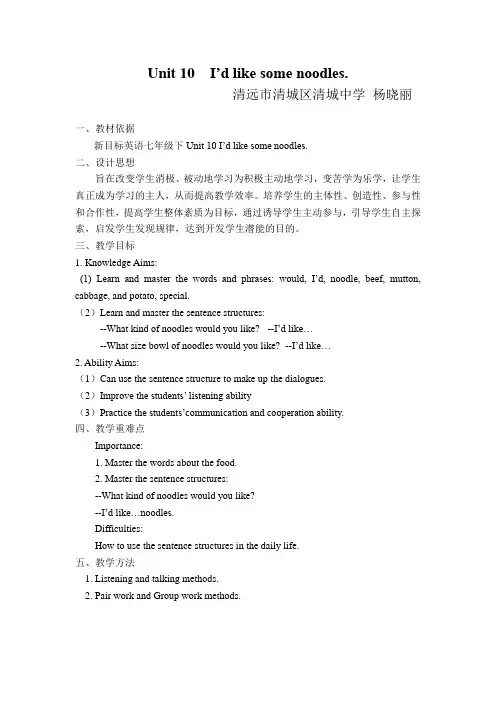
Unit 10 I’d like some noodles.清远市清城区清城中学杨晓丽一、教材依据新目标英语七年级下Unit 10 I’d like some noodles.二、设计思想旨在改变学生消极、被动地学习为积极主动地学习,变苦学为乐学,让学生真正成为学习的主人,从而提高教学效率。
培养学生的主体性、创造性、参与性和合作性,提高学生整体素质为目标,通过诱导学生主动参与,引导学生自主探索,启发学生发现规律,达到开发学生潜能的目的。
三、教学目标1. Knowledge Aims:(1) Learn and master the words and phrases: would, I’d, noodle, beef, mutton, cabbage, and potato, special.(2)Learn and master the sentence structures:--What kind of noodles would you like? --I’d like…--What size bowl of noodles would you like? --I’d like…2. Ability Aims:(1)Can use the sentence structure to make up the dialogues.(2)Improve the students’ listening ability(3)Practice the students’communication and cooperation ability.四、教学重难点Importance:1. Master the words about the food.2. Master the sentence structures:--What kind of noodles would you like?--I’d like…noodles.Difficulties:How to use the sentence structures in the daily life.五、教学方法1. Listening and talking methods.2. Pair work and Group work methods.六、教学过程I. Lead-in .1. At first, watch the video and ask students to try to remember the food they see.And then, ask students to answer: I can see…2. Show the language aims to students:(1). Master some new words of food: noodle, beef, mutton, cabbage, and potato(2). Master the sentence structures:--What kind of noodles would you like?--I’d like…noodles.(3). How to order food in English .3. Check the preview exercise.II. Presentation1. Look at the pictures about meat and vegetables, practice the sentence structures :--What kind of meat would you/he/she/they like?--I’d/He’d/she’d/they’d like some...--What kind of vegetables would you/he/she/they like?--I’d/He’d/she’d/they’d like some...2. Play a gamePay attention to the pictures that will appear on the screen, then find out the same pictures .The countable nouns will disappear but the uncountable nouns won`t.Let students work out the rules.Ⅲ. Consolidation1. Look at the picture again and teach the students:a small, large and medium bowl of noodles, then practice them.2. Give the students another sentence structure--What size bowl of noodles would you like?--I’d like a small bowl of noodles.Ask the students to practice this sentence structures.3. Group work : make a short conversation by using these sentence structures.Ⅳ. Listening Practice.A boy and a girl are in a Noodle House and they want some noodles. L et’s come to see what they would like.1. Listen to the 2a. Check the names of the food.2. Listen again and fill in the blanks. Finish 2b,then check them.V. Practice1. Finish the exercise by yourself in 3mins. Then discuss the answers with your groupmates within 1minute. If you can give the correct answers in the game, you can get some money! Only one chance for each group.2. Group work: You are a cook of No.9 Noodle House! Use the money in your group and discuss with your groupmates about what kind of food you want to buy. Think about what kind of noodles and others specials you will have in your noodle house.3. What kind of special are you going to make? Write an ad. for your noodle house. VI. Summary:Let the students say what we’ve learned. Show the sentence structures and important phrases for the students.Ⅶ. Homework:1. Cook some noodles when you stay at home on weekends .2. Using the words and expressions we’ve learnt to introduce your noodles to your family members。
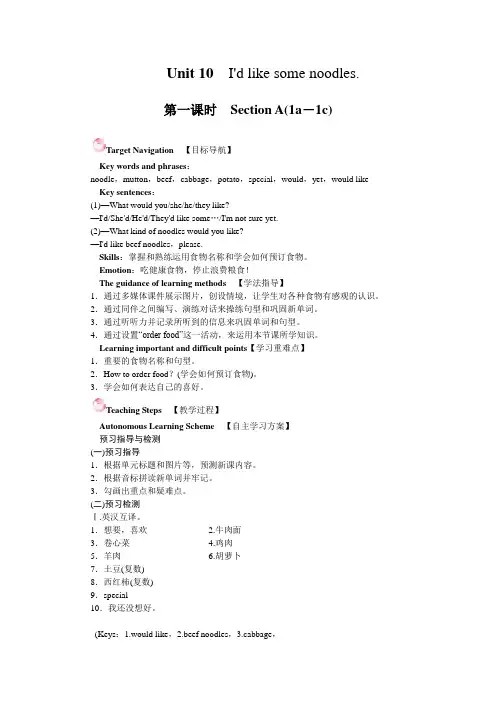
Unit 10I'd like some noodles.第一课时Section A(1a-1c)Target Navigation【目标导航】Key words and phrases:noodle,mutton,beef,cabbage,potato,special,would,yet,would like Key sentences:(1)—What would you/she/he/they like?—I'd/She'd/He'd/They'd like some…/I'm not sure yet.(2)—What kind of noodles would you like?—I'd like beef noodles,please.Skills:掌握和熟练运用食物名称和学会如何预订食物。
Emotion:吃健康食物,停止浪费粮食!The guidance of learning methods【学法指导】1.通过多媒体课件展示图片,创设情境,让学生对各种食物有感观的认识。
2.通过同伴之间编写、演练对话来操练句型和巩固新单词。
3.通过听听力并记录所听到的信息来巩固单词和句型。
4.通过设置“order food”这一活动,来运用本节课所学知识。
Learning important and difficult points【学习重难点】1.重要的食物名称和句型。
2.How to order food?(学会如何预订食物)。
3.学会如何表达自己的喜好。
Teaching Steps【教学过程】Autonomous Learning Scheme【自主学习方案】预习指导与检测(一)预习指导1.根据单元标题和图片等,预测新课内容。
2.根据音标拼读新单词并牢记。
3.勾画出重点和疑难点。
(二)预习检测Ⅰ.英汉互译。
1.想要,喜欢________ 2.牛肉面________3.卷心菜________ 4.鸡肉________5.羊肉________ 6.胡萝卜________7.土豆(复数)________8.西红柿(复数)________9.special________10.我还没想好。
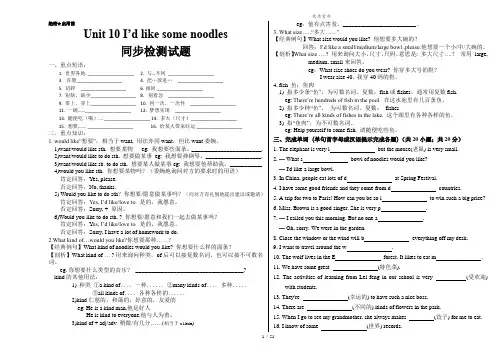
绝密★启用前Unit 10 I’d like some noodles同步检测试题一、重点短语:1. 世界各地__________________2. 与…不同__________________3. 许愿__________________4. 把…放进…__________________5. 切碎__________________6. 相同 __________________7. 短缺,缺少__________________ 8. 别着急__________________9. 带上,穿上__________________ 10. 同一次,一次性__________________11. 一碗……__________________ 12. 梦想实现__________________13. 随便吃(喝)…. __________________ 14. 多大(尺寸)__________________15. 想要……. __________________ 16. 给某人带来好运 __________________二、重点知识:1. would like“想要”,相当于want, 用法亦同want,但比want委婉。
1)want/would like sth. 想要某物eg: 我想要些面条。
________________________.2)want/would like to do sth. 想要做某事eg: 我想要弹钢琴。
___________________.3)want/would like sb. to do sth. 想要某人做某事eg: 我想要他帮助我。
___________4)would you like sth. 你想要某物吗?(委婉地询问对方的要求时的用语)肯定回答:Yes, please.否定回答:No, thanks.5) Would you like to do sth?你想要/愿意做某事吗?(向对方有礼貌地提出建议或邀请)肯定回答:Yes, I’d like/love to. 是的,我愿意。
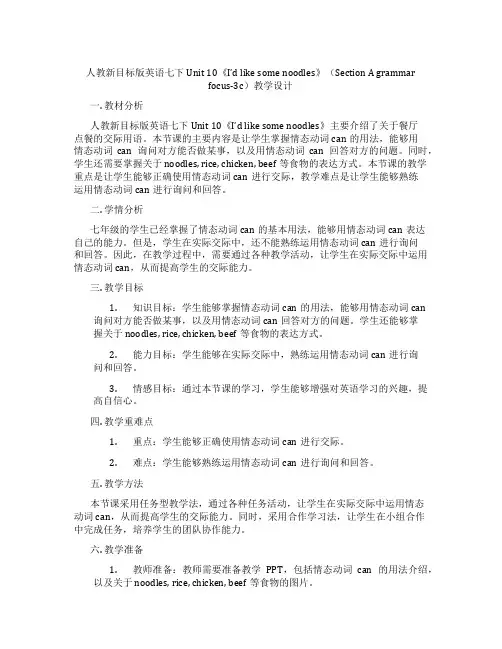
人教新目标版英语七下Unit 10《I’d like some noodles》(Section A grammarfocus-3c)教学设计一. 教材分析人教新目标版英语七下Unit 10《I’d like some noodles》主要介绍了关于餐厅点餐的交际用语。
本节课的主要内容是让学生掌握情态动词can的用法,能够用情态动词can询问对方能否做某事,以及用情态动词can回答对方的问题。
同时,学生还需要掌握关于 noodles, rice, chicken, beef等食物的表达方式。
本节课的教学重点是让学生能够正确使用情态动词can进行交际,教学难点是让学生能够熟练运用情态动词can进行询问和回答。
二. 学情分析七年级的学生已经掌握了情态动词can的基本用法,能够用情态动词can表达自己的能力。
但是,学生在实际交际中,还不能熟练运用情态动词can进行询问和回答。
因此,在教学过程中,需要通过各种教学活动,让学生在实际交际中运用情态动词can,从而提高学生的交际能力。
三. 教学目标1.知识目标:学生能够掌握情态动词can的用法,能够用情态动词can询问对方能否做某事,以及用情态动词can回答对方的问题。
学生还能够掌握关于 noodles, rice, chicken, beef等食物的表达方式。
2.能力目标:学生能够在实际交际中,熟练运用情态动词can进行询问和回答。
3.情感目标:通过本节课的学习,学生能够增强对英语学习的兴趣,提高自信心。
四. 教学重难点1.重点:学生能够正确使用情态动词can进行交际。
2.难点:学生能够熟练运用情态动词can进行询问和回答。
五. 教学方法本节课采用任务型教学法,通过各种任务活动,让学生在实际交际中运用情态动词can,从而提高学生的交际能力。
同时,采用合作学习法,让学生在小组合作中完成任务,培养学生的团队协作能力。
六. 教学准备1.教师准备:教师需要准备教学PPT,包括情态动词can的用法介绍,以及关于 noodles, rice, chicken, beef等食物的图片。
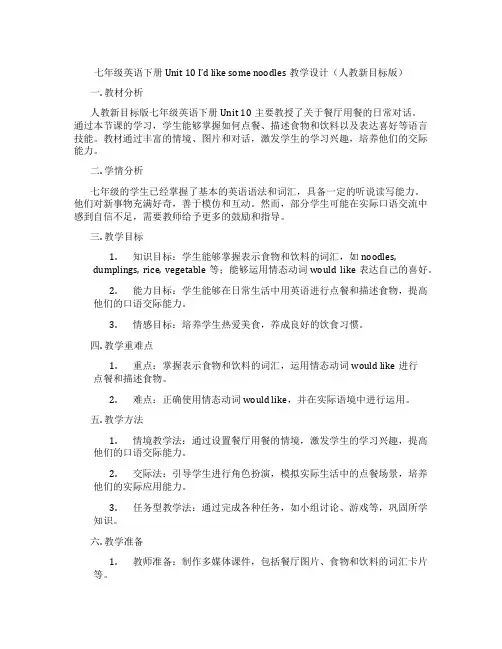
七年级英语下册Unit 10 I’d like some noodles教学设计(人教新目标版)一. 教材分析人教新目标版七年级英语下册Unit 10主要教授了关于餐厅用餐的日常对话。
通过本节课的学习,学生能够掌握如何点餐、描述食物和饮料以及表达喜好等语言技能。
教材通过丰富的情境、图片和对话,激发学生的学习兴趣,培养他们的交际能力。
二. 学情分析七年级的学生已经掌握了基本的英语语法和词汇,具备一定的听说读写能力。
他们对新事物充满好奇,善于模仿和互动。
然而,部分学生可能在实际口语交流中感到自信不足,需要教师给予更多的鼓励和指导。
三. 教学目标1.知识目标:学生能够掌握表示食物和饮料的词汇,如noodles,dumplings, rice, vegetable等;能够运用情态动词would like表达自己的喜好。
2.能力目标:学生能够在日常生活中用英语进行点餐和描述食物,提高他们的口语交际能力。
3.情感目标:培养学生热爱美食,养成良好的饮食习惯。
四. 教学重难点1.重点:掌握表示食物和饮料的词汇,运用情态动词would like进行点餐和描述食物。
2.难点:正确使用情态动词would like,并在实际语境中进行运用。
五. 教学方法1.情境教学法:通过设置餐厅用餐的情境,激发学生的学习兴趣,提高他们的口语交际能力。
2.交际法:引导学生进行角色扮演,模拟实际生活中的点餐场景,培养他们的实际应用能力。
3.任务型教学法:通过完成各种任务,如小组讨论、游戏等,巩固所学知识。
六. 教学准备1.教师准备:制作多媒体课件,包括餐厅图片、食物和饮料的词汇卡片等。
2.学生准备:预习本节课的生词和句子,了解餐厅用餐的基本礼仪。
七. 教学过程1.导入(5分钟)教师通过展示餐厅的图片,引导学生谈论他们喜欢的食物和饮料。
同时,教师询问学生:“Would you like something to eat or drink?”,让学生回答:“Yes, please./No, thank you.”,从而引出本节课的主题。

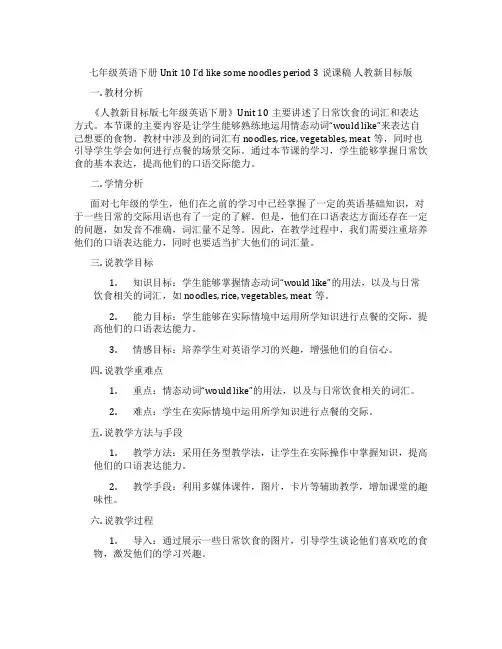
七年级英语下册Unit 10 I’d like some noodles period 3说课稿人教新目标版一. 教材分析《人教新目标版七年级英语下册》Unit 10主要讲述了日常饮食的词汇和表达方式。
本节课的主要内容是让学生能够熟练地运用情态动词“would like”来表达自己想要的食物。
教材中涉及到的词汇有noodles, rice, vegetables, meat等,同时也引导学生学会如何进行点餐的场景交际。
通过本节课的学习,学生能够掌握日常饮食的基本表达,提高他们的口语交际能力。
二. 学情分析面对七年级的学生,他们在之前的学习中已经掌握了一定的英语基础知识,对于一些日常的交际用语也有了一定的了解。
但是,他们在口语表达方面还存在一定的问题,如发音不准确,词汇量不足等。
因此,在教学过程中,我们需要注重培养他们的口语表达能力,同时也要适当扩大他们的词汇量。
三. 说教学目标1.知识目标:学生能够掌握情态动词“would like”的用法,以及与日常饮食相关的词汇,如noodles, rice, vegetables, meat等。
2.能力目标:学生能够在实际情境中运用所学知识进行点餐的交际,提高他们的口语表达能力。
3.情感目标:培养学生对英语学习的兴趣,增强他们的自信心。
四. 说教学重难点1.重点:情态动词“would like”的用法,以及与日常饮食相关的词汇。
2.难点:学生在实际情境中运用所学知识进行点餐的交际。
五. 说教学方法与手段1.教学方法:采用任务型教学法,让学生在实际操作中掌握知识,提高他们的口语表达能力。
2.教学手段:利用多媒体课件,图片,卡片等辅助教学,增加课堂的趣味性。
六. 说教学过程1.导入:通过展示一些日常饮食的图片,引导学生谈论他们喜欢吃的食物,激发他们的学习兴趣。
2.新课呈现:通过多媒体课件,展示本节课的主要内容,让学生初步感知情态动词“would like”的用法。
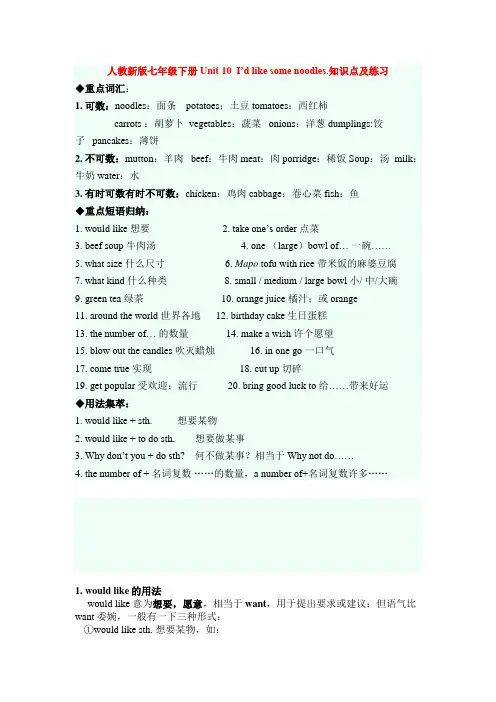
人教新版七年级下册Unit 10 I’d like some noodles.知识点及练习◆重点词汇:1. 可数:noodles:面条 potatoes:土豆 tomatoes:西红柿carrots :胡萝卜 vegetables:蔬菜 onions:洋葱 dumplings:饺子 pancakes:薄饼2. 不可数:mutton:羊肉 beef:牛肉meat:肉porridge:稀饭Soup:汤 milk:牛奶 water:水3. 有时可数有时不可数:chicken:鸡肉cabbage:卷心菜fish:鱼◆重点短语归纳:1. would like 想要2. take one‘s order点菜3. beef soup 牛肉汤4. one (large)bowl of…一碗……5. what size 什么尺寸6. Mapo tofu with rice带米饭的麻婆豆腐7. what kind 什么种类 8. small / medium / large bowl 小/ 中/大碗9. green tea 绿茶 10. orange juice 橘汁;或orange11. around the world 世界各地 12. birthday cake 生日蛋糕13. the number of…的数量 14. make a wish 许个愿望15. blow out the candles吹灭蜡烛 16. in one go 一口气17. come true 实现 18. cut up 切碎19. get popular 受欢迎;流行 20. bring good luck to 给……带来好运◆用法集萃:1. would like + sth. 想要某物2. would like + to do sth. 想要做某事3. Why don‘t you + do sth?何不做某事?相当于Why not do……4. the number of + 名词复数……的数量,a number of+名词复数许多……1. would like的用法would like 意为想要,愿意,相当于want,用于提出要求或建议;但语气比want委婉,一般有一下三种形式:①would like sth. 想要某物,如:我想要些冰淇淋。
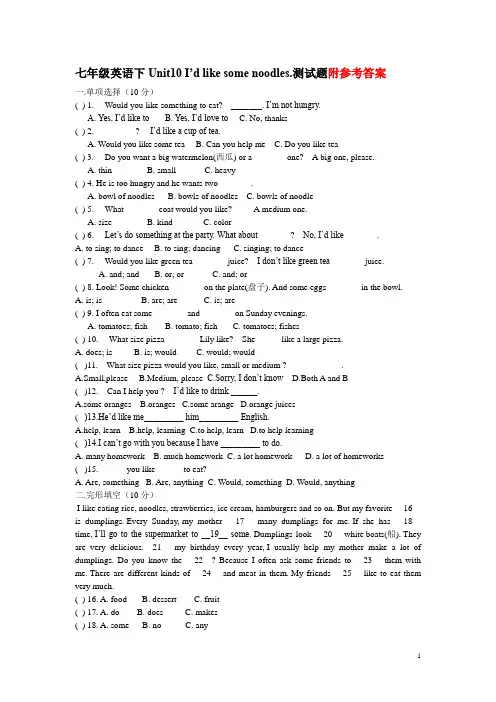
七年级英语下Unit10 I’d like some noodles.测试题附参考答案一.单项选择(10分)( ) 1. ---Would you like something to eat?---_______. I’m not hungry.A. Yes, I’d like toB. Yes, I’d love toC. No, thanks( ) 2. ---_______? ---I’d like a cup of tea.A. Would you like some teaB. Can you help meC. Do you like tea( ) 3. ---Do you want a big watermelon(西瓜) or a _______ one?---A big one, please.A. thinB. smallC. heavy( ) 4. He is too hungry and he wants two _______.A. bowl of noodlesB. bowls of noodlesC. bowls of noodle( ) 5. ---What _______ coat would you like? ---A medium one.A. sizeB. kindC. color( ) 6. ---Let’s do something at the party. What about _______?---No, I’d like _______.A. to sing; to danceB. to sing; dancingC. singing; to dance( ) 7. ---Would you like green tea _______ juice?---I don’t like green tea _______ juice.A. and; andB. or; orC. and; or( ) 8. Look! Some chicken _______ on the plate(盘子). And some eggs _______ in the bowl.A. is; isB. are; areC. is; are( ) 9. I often eat some _______ and _______ on Sunday evenings.A. tomatoes; fishB. tomato; fishC. tomatoes; fishes( ) 10. ---What size pizza _______ Lily like?---She _____ like a large pizza.A. does; isB. is; wouldC. would; would( )11.---What size pizza would you like, small or medium ? ---__________.A.Small,pleaseB.Medium, pleaseC.Sorry, I don’t knowD.Both A and B( )12.---Can I help you ?---I’d like to drink ______.A.some orangesB.orangesC.some arangeD.orange juices( )13.He’d like me_________ him_________ English.A.help, learnB.help, learningC.to help, learnD.to help learning( )14.I can’t go with you because I have _________ to do.A. many homeworkB. much homeworkC. a lot homeworkD. a lot of homeworks( )15.______ you like______ to eat?A. Are, somethingB. Are, anythingC. Would, somethingD. Would, anything二.完形填空(10分)I like eating rice, noodles, strawberries, ice cream, hamburgers and so on. But my favorite __16__ is dumplings. Every Sunday, my mother __17__ many dumplings for me. If she has __18__ time, I’ll go to the supermarket to __19__ some. Dumplings look __20__ white boats(船). They are very delicious.__21__ my birthday every year, I usually help my mother make a lot of dumplings. Do you know the __22__? Because I often ask some friends to __23__ them with me. There are different kinds of __24__ and meat in them. My friends __25__ like to eat them very much.( ) 16. A. food B. dessert C. fruit( ) 17. A. do B. does C. makes( ) 18. A. some B. no C. any( ) 19. A. want B. order C. buy( ) 20. A. for B. at C. like( ) 21. A. In B. On C. About( ) 22. A. kind B. size C. reason( ) 23. A. eat B. drink C. like( ) 24. A. noodles B. dumplings C. vegetables( ) 25. A. all B. every C. both三.阅读理解(20分)AOur school is on Heping Street. It’s next to the People’s Hospital. There is a big garden across from our school. The pay phone is between our school and the post office. There are three buildings(楼房) in ou r school, the students’ building, the teachers’ building and the library. The teachers in our school are very good. Our school is very beautiful. If you come to our school from the airport, take a taxi and go down Long Street. When you see a bridge, go across the bridge and turn right. Just go down Heping Street. Our school is on the right.根据短文内容判断句子正(T)误(F)。
Unit 10 I’d like some noodles.【教学重点难点】: 1.would like 的意义和用法; 2.学会预定食品 3.学会介绍你对不同食品的喜好4.学会怎样用would like 表请求和意愿【教学目标】1.知识与技能:能利用重点句型和新单词定餐,介绍对不同食物的喜好.2、过程与方法:通过图片、收音机等教具的运用,采用Task-based Language Teaching教学,让学生从视听说上把握本单元的学习内容.3、情感态度与价值观:让学生通过对本单元的学习养成健康的饮食习惯.第1课时【学习内容】: Section A 1a—2c【学习目标】:一. New Words:1.I'd like some noodles.我想要一些面条。
would是情态动词,无人称和数的变化, I’d =I would ,he’d=he would,(1)would like=want 表示“希望,想要”,但比want语气委婉,would like /want sb. to do sth.”想要某人做某事would like/want sth.想要某物; would like/want to do sth.想要做某事would like to do sth. 想要做某事would like sb. to do sth. 想要某人去做某事He would like to go out for a walk.他想要出去散步。
Our parents would like us to study well.我们的父母想要我们好好学习。
(2)“Would you like sth.?(你想要某东西吗?)”也是日常生活中用来征求对方许可的一种委婉、礼貌的句型,其肯定回来为“Yes, please./否定回答为“No, thanks.”eg: -Would you like some chicken? 你想要些鸡肉吗?-Yes, please.好的。
人教版新目标英语七年级下册《Unit 10 I’d like some noodles》优质课教学设计一. 教材分析人教版新目标英语七年级下册《Unit 10 I’d like some noodles》主要介绍了日常生活中的食物和饮料。
本节课以食物和饮料为主题,通过学习让学生能够熟练运用一般现在时表达喜好,并能够进行简单的购物交流。
本节课的主要内容有:食物和饮料的词汇,一般现在时的表达方式,以及如何用英语进行购物。
二. 学情分析七年级的学生已经掌握了基本的英语语法和词汇,具备一定的听、说、读、写能力。
但是,对于一些食物和饮料的词汇以及一般现在时的运用可能还不够熟练。
因此,在教学过程中,需要注重词汇的教学和语法点的讲解,同时,引导学生进行实际操作,提高他们的实际运用能力。
三. 教学目标1.知识目标:学生能够掌握本节课的食物和饮料词汇,理解一般现在时的表达方式,并能够运用所学知识进行简单的购物交流。
2.能力目标:学生能够听、说、读、写本节课的词汇和句型,提高他们的英语表达能力。
3.情感目标:通过本节课的学习,学生能够培养对英语的兴趣,增强自信心,提高合作意识。
四. 教学重难点1.重点:食物和饮料的词汇,一般现在时的表达方式。
2.难点:一般现在时的运用,购物场景的交流。
五. 教学方法采用任务型教学法,情境教学法,分组合作学习法,以及游戏教学法等多种教学方法,激发学生的学习兴趣,提高他们的参与度和积极性。
六. 教学准备1.教师准备:准备好食物和饮料的图片、实物,以及相关的教学材料。
2.学生准备:预习本节课的词汇和句型,准备好笔记本和文具。
七. 教学过程1.导入(5分钟)教师通过展示一些食物和饮料的图片,引导学生进行观察和思考,激发他们的学习兴趣。
然后,询问学生他们喜欢什么食物和饮料,引出本节课的主题。
2.呈现(10分钟)教师展示本节课的食物和饮料词汇,以及一般现在时的表达方式,引导学生进行观察和理解。